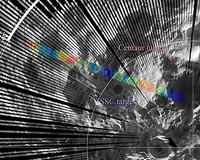|
|
|
NASA Spacecraft Impacts Lunar Crater In Search For Water Ice Moffett Field CA (SPX) Oct 12, 2009  NASA's Lunar Crater Observation and Sensing Satellite, or LCROSS, created twin impacts on the moon's surface early Friday in a search for water ice. Scientists will analyze data from the spacecraft's instruments to assess whether water ice is present. The satellite traveled 5.6 million miles during an historic 113-day mission that ended in the Cabeus crater, a permanently shadowed region ... read more
NASA's Lunar Crater Observation and Sensing Satellite, or LCROSS, created twin impacts on the moon's surface early Friday in a search for water ice. Scientists will analyze data from the spacecraft's instruments to assess whether water ice is present. The satellite traveled 5.6 million miles during an historic 113-day mission that ended in the Cabeus crater, a permanently shadowed region ... read moreUBC Engineering Students Unveil Moon Dust-Shoveling Robot  Vancouver, Canada (SPX) Oct 12, 2009
Vancouver, Canada (SPX) Oct 12, 2009A robot designed by UBC students will be shoveling moon dust at an international robotics competition next week, vying for a $500,000 prize and the opportunity to contribute to NASA's future space exploration projects. The UBC team has created a robotic machine that can excavate simulated lunar soil (regolith). Excavating regolith will be an important part of any construction project or ... more
|
Vietnam says parched Red River at record low
China to be world's third biggest wind power producer: media Cost-cutting NASA eyes three cheap space missions Honduras declares state of emergency amid drought Russia in secret plan to save Earth from asteroid: official Sarkozy scrambles to salvage carbon tax French carbon tax ruled illegal Brazil's Lula signs law cutting CO2 emissions 2009 a 'benign' year of natural disasters: German re-insurer Greenpeace Spain demands Denmark release its director
| |||||||||||||||
| Previous Issues | Oct 13 | Oct 12 | Oct 09 | Oct 08 |
| . |
Hubble Observes LCROSS Impact Event Pasadena CA (SPX) Oct 12, 2009
Pasadena CA (SPX) Oct 12, 2009NASA's Hubble Space Telescope has made a series of observations immediately preceding and following the Lunar Crater Observation and Sensing Satellite (LCROSS) Centaur rocket stage and shepherding spacecraft impacts at the lunar south pole, on October 9 at 7:31 and 7:35 a.m. EDT. Hubble's Wide Field Camera 3 (WFC3) and Space Telescope Imaging Spectrograph (STIS) were pointed just off the ... more NASA blasts moon with rocket in search for water  Washington (AFP) Oct 9, 2009
Washington (AFP) Oct 9, 2009The United States successfully blasted a rocket into the moon on Friday, slamming it into a crater near the lunar south pole in a bid to discover water, US space agency NASA said. No light flash was visible in the thermal images broadcast on NASA television, as the 2.3-tonne rocket impacted the Cabeus crater at 1131 GMT. A second shepherding spacecraft flew through the debris plume, coll ... more Europa's Ocean Contains Enough Oxygen To Support Life  Tucson AZ (SPX) Oct 09, 2009
Tucson AZ (SPX) Oct 09, 2009The global ocean on Jupiter's moon Europa contains about twice the liquid water of all the Earth's oceans combined. New research suggests that there may be plenty of oxygen available in that ocean to support life, a hundred times more oxygen than previously estimated. The chances for life there have been uncertain, because Europa's ocean lies beneath several miles of ice, which separates ... more |
. |
| . |
Southern Arizona Telescopes Will Point At Lunar Impact Early Friday Tempe AZ (SPX) Oct 08, 2009
Tempe AZ (SPX) Oct 08, 2009Astronomers at the some of the best ground-based telescopes in southern Arizona plan to observe two lunar impacts at 4:30 a.m. and 4:34 a.m. Arizona time Friday, Oct. 9. NASA is scheduled to fire a two-ton Centaur rocket, and four minutes later its shepherding spacecraft, into a crater at the moon's south pole for the Lunar Crater Observation and Sensing Satellite mission, known as LCROSS ... more Updated SMART-1 Image Of New Target For LCROSS Impact  Paris, France (ESA) Oct 08, 2009
Paris, France (ESA) Oct 08, 2009The European Space Agency's SMART-1 team has released an updated image of the future impact site of NASA's Lunar Crater Observation and Sensing Satellite (LCROSS), after the LCROSS team announced a new target last week. LCROSS will search for water ice on the Moon by making two impacts into a crater named Cabeus at the lunar South Pole. The impacts are scheduled for 11:31:19 UTC and 11:35:45 UTC ... more LCROSS Viewer's Guide  Huntsville AL (SPX) Oct 06, 2009
Huntsville AL (SPX) Oct 06, 2009Just imagine. A spaceship plunges out of the night sky, hits the ground and explodes. A plume of debris billows back into the heavens, leading your eye to a second ship in hot pursuit. Four minutes later, that one hits the ground, too. It's raining spaceships! Put on your hard hat and get ready for action, because on Friday, Oct. 9th, what you just imagined is really going to happen ... more |
. |
| Previous Issues | Oct 13 | Oct 12 | Oct 09 | Oct 08 |
| The contents herein, unless otherwise known to be public domain, are Copyright 1995-2009 - SpaceDaily. AFP and UPI Wire Stories are copyright Agence France-Presse and United Press International. ESA Portal Reports are copyright European Space Agency. All NASA sourced material is public domain. Additional copyrights may apply in whole or part to other bona fide parties. Advertising does not imply endorsement, agreement or approval of any opinions, statements or information provided by SpaceDaily on any web page published or hosted by SpaceDaily. Privacy statement |